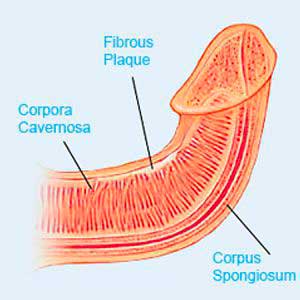Scratch Technique
Peyronie’s disease, also known as Induratio Penis Plastica or chronic inflammation of the tunica albuginea of the corpus cavernosum, is a disease involving the formation of calcified fibrous plaques within the penis. It affects 5% of men.
The pathology can cause pain, penile deformity, an hourglass effect and abnormal curvature of the erect penis due to chronic inflammation of the tunica albuginea. A commonly held erroneous belief is that Peyronie’s disease always leads to curvature of the penis.
The scar tissue often leads to deformities or shortening rather than curvature. The condition can also make sexual intercourse painful and difficult until the disease process leads to atrophy. Almost 25% of patients seeking a penile prosthetic implant have a form of Induratio Penis Plastica.
The average patient age is 58.
10% have a mild form of the condition, 10% moderate and 80% have a severe form of Peyronie’s disease. It is more common than people think. It is no doubt related to diabetes, which causes endothelial damage and thus fibrosis of the corpus cavernosum, but it is also associated with “vigorous” sexual activity.
Early diagnosis is extremely important. A question of days can make all the difference.
The use of integrators as part of the treatment plan for Peyronie’s disease can be of help but does not resolve the problem.
Iontophoresis, low frequency shock waves and laser therapy are of value in selected cases. The Vacuum device is very useful both as a preventative measure as well as for the purposes of maintaining the post-operative result. The Vacuum device is a mechanical device using a vacuum created by a pump to stretch penile structures (smooth muscle and tunica albuginea) and to draw blood into the corpus cavernosum, also for the purpose of inducing an erection. The device essentially consists in a large silicone cylinder with an appropriate adaptor, into which the patient’s flaccid penis is inserted and a pump (manual or electric) connected to the cylinder so as to aspirate air, creating negative pressure of up to 450 mmHg.
Maintenance time and vacuum management will be suggested in the recovery phase based on the pathology present. The Vacuum device can be used to treat forms of erectile dysfunction as an alternative to first-line therapies. There are other pathological conditions which can be treated using the Vacuum device: these include situations in which the penis may undergo retraction or shortening, such as, for example, the shortening of the penis which may be observed following a radical prostatectomy.
In this case, the penile stretching associated with the oxygenation of the corpus cavernosum can prevent the retraction seen following the loss of erectile function, in advance of the insertion of a prosthetic penile implant. According to the same principle, in cases of shortening due to Induratio Penis Plastica, the use of the Vacuum device can help to slow down the retraction-related shortening of the albuginea characteristic of the disease.
In our practice, men aged over 50 with any degree of erectile dysfunction are candidates for the implantation of a penile prosthesis. Correcting the curvature alone will not guarantee and improvement in erectile function. Indeed, in all likelihood, such patients will need to undergo another procedure. However, waiting too long will lead to shortening of the penis. Carrying out the surgical procedure soon after will avoid further length loss.
When the penile prosthesis is inserted, we use a new approach to correct the curvature and defects of the tunica albuginea using the “Scratch” technique. Concretely, the fibrosis is broken from within and the shaft is re-modelled prior to implanting the prosthesis.

The Journal of Sexual Medicine – Surgical Technique
Minimally Invasive Infrapubic Inflatable Penile Implant
(continua)
Inflatable Penile Prosthesis Placement
Inflatable Penile Prosthesis Placement, Scratch Technique and Postoperative Vacuum Therapy as a Combined Approach to Definitive Treatment of Peyronie’s Disease.
(continua)
